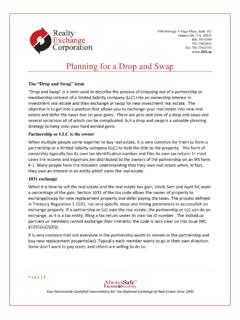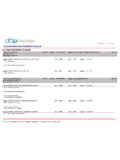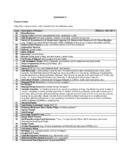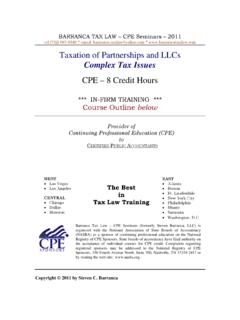Transcription of Reporting the Like-Kind Exchange of Real Estate …
1 Reporting the Like-Kind Exchange of Real Estate Using IRS Form 8824. 2015 Tax Return Edition Compliments of Realty Exchange Corporation Your Nationwide Qualified Intermediary for the Tax Deferred Exchange of Real Estate . AlwaysSafe TM. Escrow Security 800-795-0769. Local (703) 754-9411. Fax: 703-754-0754. 7400 Heritage Village Plz #102. Gainesville, VA 20155. Also available at This publication is designed to provide accurate and authoritative information in regard to the subject matter covered. It is presented with the understanding that the publisher is not engaged in rendering legal or accounting service. If legal or other assistance is required, the services of a competent professional should be sought . From a Declaration of Principals jointly adopted by a com- mittee of the American Bar Association and a committee of publishers and associations.
2 1990 - 2015 by Ed Horan Gainesville, VA IRS 8824 Workbook 2015 Tax Return Edition Reporting THE Exchange . These instructions were originally developed in the early 1990s when the IRS Form 8824 was first created. The IRS Form 8824 is very complicated and uses terms with which most exchangers are not familiar. As exchangers had many questions, this Workbook was published to be of assistance to them to properly report an Exchange . While the author is not engaged in rendering legal or accounting service, every effort has been made to insure the guidance is in agreement with the current IRS Form 8824. instructions. Today, many taxpayers use tax preparers or commercial software. These instructions and the use of the enclosed worksheet help exchangers confirm that the other programs are not asking you to pay more taxes.
3 If there is a conflict/difference, you should know why. Do not hesitate to email the author with your worksheet numbers to ask for clarification or explain any differences. In the early years of exchanging it was common for the property owners to assume the loan on the property they were receiving. Today, most banks/lenders will not allow the assumption of a loan. However, most IRS instructions still provide examples of loans being assumed. This causes major confusion. With the use of the deferred Exchange . rules (IRS regulation (k)-(1) for most all 1031 exchanges, owners are getting new loans/mortgages. 1. WHEN DO WE REPORT THE Exchange TO THE IRS? The Exchange is reported to the IRS for the tax year in which the first relinquished property is transferred, even if the replacement property(ies) was transferred in the following tax year.)
4 Example: Exchanger settles on relinquished property on Dec. 14, 2015, and then settles on replacement property May 1, 2016. Exchanger would file IRS Form 8824 with 2015 return, after filing an on-time request for an extension. 2. HOW DO WE REPORT THE Exchange ? The Exchange is reported on IRS Form 8824, Like-Kind Exchanges. The Form 8824 is divided into four parts: Part I. Information on the Like-Kind Exchange Part II. Related Party Exchange Information Part III. Realized Gain or (Loss), Recognized Gain, and Basis of Like-Kind Property Received Part IV. Not used for 1031 Exchange Used only for Section 1043 Conflict of Interest Sales. If the exchanger has recognized gain, in addition to IRS Form 8824, the exchanger may need to report the gain on IRS Form 4797, Sales of Business Property, Schedule D (IRS.)
5 Form 1040), Capital Gains and Losses, and/or IRS Form 6252, Installment Sale Income. See paragraph 6 below. IRS has made it clear not to report the sale of Exchange property on Form 8949 when Reporting an Exchange on Form 8824. If you made more than one Like-Kind Exchange in the same year you should file only one summary Form 8824 and attach your own statement showing all the information requested on Form 8824 for each Exchange . Include your name and tax ID number at the top of each page of the statement. On the summary IRS Form 8824, enter only your name and tax ID number, the word Summary on Line 1, the total recognized gain from all exchanges on Line 23, and the total basis of all Like-Kind property received on Line 25. IRS 8824 Workbook 1. 2015 Tax Return Edition 3. COMPLETING PART I INFORMATION ON THE Like-Kind Exchange .
6 For Lines 1. and 2 in Part I, the exchanger should show for real property the address and type of property. For personal property a short description of the property should be entered. All property involved in each Exchange is included on the single Form 8824. Include an attachment if additional space is required. Line 5 is normally the date the qualified intermediary was provided the identification of the replacement property. In the event the replacement property settled prior to the 45th day, then separate identification is not required, and the transfer date for the replacement property is shown on Line 5. The date on Line 5 should be and is usually no later than 45 days after the date you transferred the relinquished property as shown on Line 4. 4. COMPLETING PART II RELATED PARTY Exchange INFORMATION.
7 Part II is only completed when the replacement property was purchased/acquired from a related party, directly or indirectly. A related party includes the exchanger's spouse, child, grandchild, parent, grandparent, brother or sister, or a related corporation, S corporation, partnership, or trust in which the exchanger has over a 50% interest. See IRC Section 1031(f). Before marking YES on Line 7, form 8824 be certain that the other party in to Exchange is a related person. For instance an in-law while related, is not a related party for tax purposes. If the Exchange is made with a related party (and an exception does not apply), then you must also file Form 8824 for the two years following the year of the Exchange . See specific Form 8824 Instructions for Line 7. There have been a number of exceptions and clarifications on related party exchanges.
8 If in doubt a tax advisor should be consulted before claiming the Exchange involved a related party. If necessary see specific form 8824 instructions for Line 7 and Part III. 5. COMPLETING PART III REALIZED GAIN OR (LOSS), RECOGNIZED GAIN, AND BASIS. OF Like-Kind PROPERTY RECEIVED. Part III is the most important and most difficult part of the form to complete. Part III provides for the Reporting of: a. Ordinary gain (or loss) on other property' ( non-like property) given up (see Lines 12, 13, and 14). b. Ordinary income under the recapture rules (see Lines 21 and 22, and Instructions). Do not confuse with recapture of Section 1250 depreciation. There is no recapture if depreciable real property is exchanged for other depreciable real property. If depreciable real property is exchanged for non-depreciable real property (ex: rental house for land) then the total depreciation taken in excess of straight line could be recaptured.
9 If the value of depreciable property received in the Exchange ( improvements to the land) exceeds the amount of additional or excess depreciation, then no depreciation will be recaptured. Few properties exist today that have excess depreciation. c. Multi-Asset Exchanges. Note that multi-asset exchanges are covered in detail in Section (j)-1 of the regulations. An Exchange is only reported as a multi-asset Exchange if the exchanger transferred AND received more than one group of like- kind properties, cash or other (not Like-Kind ) property. Few real Estate exchanges are multi-asset exchanges. See Page 1 of the Instructions for Form 8824 on multi-asset exchanges and Reporting of multi-asset exchanges. d. Realized Gain, Recognized Gain and Basis of Like-Kind Property Received.
10 This is the primary purpose of Part III and IRS Form 8824. To complete Part III, starting with Line 15, requires the use of our blank Worksheet on Page 10. IRS 8824 Workbook 2. 2015 Tax Return Edition The following example is used throughout this workbook, and a completed Worksheet using this example is on Page 9. EXAMPLE: To show the use of the Worksheet, we will use the following example of an Exchange transaction. In most exchanges all tax is deferred. In this example, however, the exchanger will buy down in value and receive excess Exchange escrow funds. 1. Basis. The cost basis in the property being relinquished (with improvements). is $150,000, and $45,000 has been taken in depreciation over a ten-year period. 2. Relinquished Property. The relinquished property contract price is $500,000, and the current debt to be paid off at settlement is $90,000.






